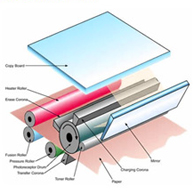
Xerografia
photocopying technique
The term xerografia was coined by combining the Greek word xeroòs (dry) and the French word graphie (writing).
The xerographic technique, also called electro photography, is a system for copying invented by American scientist Chester Carlson in 1938 and patented in 1942 (under number 2297691).
Chester Carlson spent eight years trying to find a manufacturer that appreciated the validity of his invention and was willing to invest in his project. Among those who rejected his proposal for the industrial creation of the photocopy machine were the famous IT manufacturer IBM and the US military bodies (US Army Signal Corps).
The mass production of the machine was then undertaken by the Haloid company, and the technique was officially called xerography. The first photocopiers were then introduced onto the international market, whose characteristics would be widely appreciated by a wide variety of professionals including artists and designers.
The word xerox is registered as a trademark and the Haloid company changes its name to Haloid Xerox. It then changed its name again to become Xerox Corporation.
A xerography machine consists of an aluminum drum covered with amorphous selenium which, rotating without being exposed to light, in conditions where selenium is electrically insulating, receives a positive electric charge through electrification and is subsequently exposed to the highly brilliant image of the object, provided by a suitable optical device.
The parts of the drum surface corresponding to the light areas of the image lose their electrical charge, as here the selenium becomes conductive, while those corresponding to the dark areas remain charged.
A powder (toner) consisting of a pigmented thermoplastic resin is sprayed onto the drum which, becoming negatively electrified by rubbing, adheres, due to electrostatic actions, only to the charged areas and then is transferred onto a sheet of paper, positively electrified, made to adhere to the drum.
Finally, a short and intense heating causes the powder to definitively adhere to the sheet, with the formation of a faithful copy of the original print on the latter.
Xerigraphy is the basis of the photocopying techniques currently in use.

